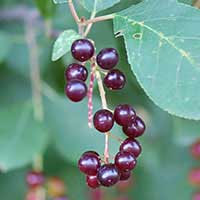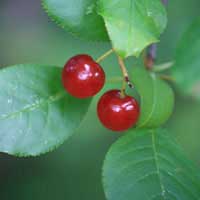 Full List of Fruits
Full List of Fruits  Chokecherry Fruit
Chokecherry FruitChokecherry Fruit
![]() Introduction of Chokecherry Fruit
Introduction of Chokecherry Fruit
Scientific name - Prunus virginiana
The chokecherry goes a scientific name Prunusvirginiana, belonging to the Rosaceae family and Prunus genes. Chokeberry grows up to be a large shrub or s small tree, this tree can normally be spotted growing in cluster that individual trees. The fruiting plant has bushes that grow up to 15 feet tall with a width of 3 inches in diameter. In rare cases the fruiting plant may reach 40 feet in height and can grow about a foot in diameter on the extreme side fruits can also be occasionally produced on plants that grow only up to 3 feet tall. Chokecherry bushes are completely deprived of thorns; they do not bare any sorts of thorns on their branches fruits or even on the follicles of the flower.
This plant is a late bloomer and blooms during spring season just in time when the leaves are about fully grown. Chokeberry bears flowers that grow symmetrical 5 petals. Growing in a tight arched position attached to a long pedicle at the bottom of every flower.
The mature fruit of the chokecherry is sphere shaped or oblong, occasionally it even spots a pointed tip. Chokecherry bears a dark purple to black color to signify that they are fully ripe. The cherries are borne in a drooping position with six inches long stalks bearing eight to twenty fruits on each cluster.
It is rather a lesser known fact that one of the species of the plant, i.e the wild chokecherry is often considered a pest, as it gives room for the tent caterpillar to feed on thus posing as a threat to other fruits.
Having mentioned that one of popularly grown and propagated species of this berry is known as Goertz which possess a nonastringent flavor and is more palatable fruit. When compared to its other variants. A research at the University of Saskatchewan is dedicated to find and create new methods of propagation and cultivars to increase production of Chokeberries.
Chokecherries though remind us of an unfamiliar but an unpleasant name is also often known with varied other names across the globe them being eastern chokecherry, western chokecherry, California chokecherry, wild cherry, wild black cherry, black chokecherry or chokeberry, rum chokecherry, whiskey chokecherry, chuckley-plum, sloetree, cabinet cherry, and in French, cerisier de virginie, cerisier, cerisier a grappes, cerisiersauvage, and caupulin.
![]() Nutritional Value of Chokecherry Fruit
Nutritional Value of Chokecherry Fruit
| Nutrients | Amount |
|---|---|
| Total Calories | 249 kcal |
| Vitamin A | 258.72 IU |
| Vitamin C | 8.47 mg |
| Vitamin K | 32.494 mcg |
| Calcium | 92.4 mg |
| Magnesium | 41.58 mg |
| Potassium | 583.66 mg |
| Phosphorus | 103.18 mg |
| Total Carbohydrates | 51.7748g |
| Sugars | 14.4298g |
| Dietary Fiber | 30.8g |
| Total Fat | 2.6026g |
The Chokecherry has a very strong flavor and is often eaten raw or cooked preferably added as a key ingredient in making pies and jams. This fruit is often a key ingredient in making wines after aging it. The raw consumption of this fruit is normally done when this fruit is fully matured. A special mention of the utility of the bark and twigs of chokecherry as they are used often as tea substitute.
This fruit has also been renowned for its poisonous property, the seed containing high concentrations of hydrogen cyanide, is a poison that gives almonds their distinctive flavor. The toxic substance can be readily detected by its bitter taste. While it is said that the poison is usually present in too small of a quantity to do any harm, any bitter seed or fruit should not be eaten.When present in moderate to larger measures hydrogen cyanide can have fatal results, it cause respiratory failure and even death. There were casualties reported where a number of livestock and children suffered respiratory failures often leading to death. Livestocks do not cherish the taste of these leaves but sometimes are forced to feed on them during droughts or famines.
![]() Health benefits of Chokecherry Fruit
Health benefits of Chokecherry Fruit
The Chokecherry has a very strong flavor and is often eaten raw or cooked preferably added as a key ingredient in making pies and jams. This fruit is often a key ingredient in making wines after aging it. The raw consumption of this fruit is normally done when this fruit is fully matured.
A special mention of the utility of the bark and twigs of chokecherry as they are used often as tea substitute.
This fruit has also been renowned for its poisonous property, the seed containing high concentrations of hydrogen cyanide, is a poison that gives almonds their distinctive flavor. The toxic substance can be readily detected by its bitter taste. While it is said that the poison is usually present in too small of a quantity to do any harm, any bitter seed or fruit should not be eaten.When present in moderate to larger measures hydrogen cyanide can have fatal results, it cause respiratory failure and even death. There were casualties reported where a number of livestock and children suffered respiratory failures often leading to death. Livestocks do not cherish the taste of these leaves but sometimes are forced to feed on them during droughts or famines.
Propagation of chokecherry can be achieved through several methods. Seeds can be collected from mature fruit and sown directly into the soil. The seedlings should be thinned to space them out as they grow. Another method is to take cuttings from mature plants and root them in moist soil. These cuttings should be taken from the tips of current season's growth in late summer or early fall.
Both of these methods require patience and careful attention to ensure success. It is important to keep the soil moist, but not waterlogged. The seedlings and cuttings should not be exposed to direct sunlight, as this can cause leaf burn.
To encourage proper fruit production, chokecherry plants should be pruned once a year. Pruning should be done in late winter or early spring before new growth begins. When pruning, it is important to remove any dead, diseased, or broken branches. All other branches should be cut back to reduce the size of the shrub and encourage new growth.Chokecherry is a valuable plant with many uses. Its fruit can be used to make jams, jellies, syrups, and wines. It is also an important food source for wildlife and has many medicinal uses. Propagation through seeds or cuttings is a simple yet time-consuming process. With careful attention and patience, chokecherry plants can be successfully propagated and grown for many years.
Harvesting chokecherry fruit starts with the selection of mature fruit. The fruit should be deep purple in color and firm to the touch. The stems should be green and pliable. The fruit should have a tart, astringent flavor.Once the fruit is selected, it should be harvested quickly to prevent spoilage. The best time to harvest chokecherry is in the late summer or early fall when the fruit is ripe. Care should be taken to avoid bruising the fruit. Gentle shaking of the branches will cause the ripe fruit to fall into a bucket or sheet placed underneath.
The harvested chokecherry fruit can be used right away or stored for later use. It can be frozen or canned for long-term storage. The fruit can also be made into jams, jellies, wines, and syrups. Chokecherry can be difficult to find in stores, but it is available at some farmers markets and specialty stores. It can also be grown in the home garden. The best time to plant chokecherry is in the spring after the last frost. The plants need full sun and should be watered regularly. Harvested chokecherry fruit can be eaten fresh, cooked, or preserved. It can be added to salads, desserts, sauces, and other recipes. The leaves can also be brewed into a tea. Chokecherry is high in antioxidants and vitamins, and it has many health benefits. It can help reduce inflammation, improve digestion, and boost the immune system. Chokecherry is a versatile fruit that can be used in many ways. It is a popular flavoring for jams, jellies, and wines. It is also a nutritious snack that can be eaten fresh or cooked. Harvesting the fruit can be done in the late summer or early fall, and it should be stored or used quickly to prevent spoilage.


















